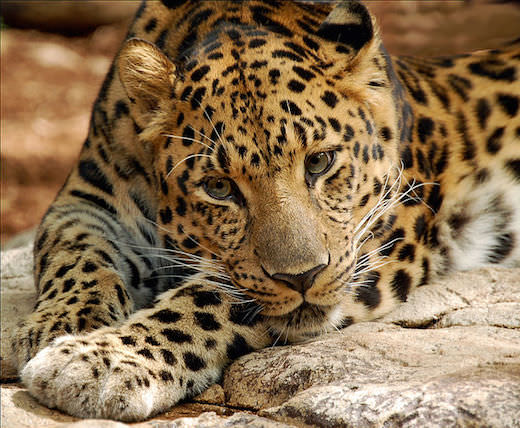Amur Leopard

Critically endangered
Also referred to as the Far Eastern Leopard, the Amur leopard is a critically endangered subspecies of leopard native to southeastern Russia and northeastern China. Characterized by a much thicker coat than other leopard species, the Amur leopard's coat also shows strong pattern differences. The dark rosettes on the Amur leopard's hind quarters often measure 5cm by 5cm and in every case sit at the center of unbroken dark ring patterns. Because of the colder climate which the Amur leopard inhabits its coat is also made up of longer, softer hair. Likewise, the brightness of the Amur leopard's coat is known to darken during summer months before becoming paler again during colder winter weather.
Weighing between 94 and 106 pounds, the Amur leopard is also smaller in comparison to other leopard species. However, the Amur leopard's smaller size is likely due to the species adapting to its present natural habitat as no other leopard species is adapted to cold snowy environments.
Population Distribution
The Amur leopard once ranged from South Beijing to Korea and even as far north as Vladivostok. Presently Amur leopards continue to inhabit parts of Russia, North Korea and China, however, the species has suffered significant decline and populations are both scattered and restricted to nature reserves and otherwise inaccessible/hard to reach areas. In Russia, the last surviving Amur leopards are found only in an area southwest of Primorye on the border with China and North Korea. Meanwhile camera traps have confirmed the presence of the Amur leopard in the Chinese provinces of Wangqing, Hunchun and Jilin. However, the only evidence for the Amur leopard's continued existence in North Korea comes from a 2009 North Korean government web page detailing a population in residence in North Korea's Myohyangsan Nature Reserve.
Threats
Estimated to number between just 19-26 in the wild, the Amur leopard species faces numerous challenges to its continued survival. Living wild, the Amur leopard is known to compete for prey and territory with Amur tigers. Likewise, such interaction with other carnivores threatens the Amur leopard with exposure to disease. Having such a small number of wild Amur leopards, the species is also threatened by inbreeding-associated health problems. In fact, of three wild Amur leopards examined by the Wildlife Conservation Society between 2006 and 2009, all were discovered to have significant heart murmurs.
To make matters worse, the Amur leopard is also poached by hunters who want to acquire the leopard's coat and bones for sale on Asian black markets. Likewise, hunters are known to kill Amur leopards simply to eradicate natural competition for wild game, as well as in retaliation for Amur leopards occasionally preying on domestic animals. In fact, hunting is a significant problem for the Amur leopard due to most of the species' surviving territory being located in easily accessible and already popular hunting grounds.
With habitat degradation via annual forest fires and ongoing development of the Amur leopard's remaining wild habitat, the species is subsequently considered critically endangered.